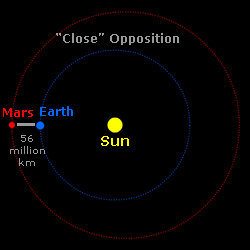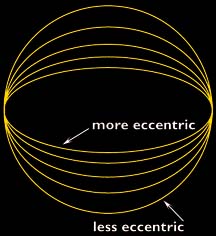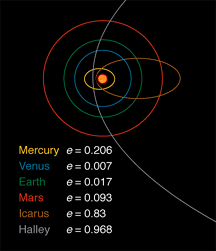Click on image for full size
Windows to the Universe original artwork by Randy M. Russell
Mars Opposition in August 2003
News story originally written on August 7, 2003
On August 27, 2003, Earth and Mars will be closer together than they have been in thousands of years. The centers of the two planets will be 55,758,006 kilometers (34,646,418 miles) apart at 9:51 Universal Time on that date. Astronomers have calculated that the last time Earth and Mars were closer together was nearly 60,000 years ago! The last people to get a better view of Mars than the one we will have in late August were Neanderthals!
Planets that are closer to the Sun move faster than planets further away. Since Earth is closer to the Sun than Mars is, Earth passes Mars about once every 26 months. The situation is similar to a fast race car passing a slower car on the "inside lane" of an oval racetrack. When Earth passes Mars, astronomers call the event an "opposition". During an opposition, the Sun, Earth, and Mars form a straight line, with Mars on the opposite side as the Sun as viewed from Earth. Not all oppositions are created equal. Since Mars's orbit is elliptical or oval-shaped (unlike Earth's, which is nearly a perfect circle), some oppositions bring the two planets closer together than others. "Close" oppositions occur when Earth passes Mars at the point in Mars's orbit when Mars is closest to the Sun. Such "close" oppositions happen once every 15 or 17 years. The most recent was in September of 1988.
This time around the opposition is a really, really close one. The orbits of Mars and Earth change slightly over very long time periods, and the alignment this year at opposition happens at just the right time to bring the planets especially close together. During this opposition Mars will appear especially bright and especially large. Mars will shine at a magnitude of -2.9, and will appear to be 25.11 arcseconds in diameter in the sky. It will be far brighter than any star, and brighter than any planet except for Venus.
How big of a deal is this? Well, to tell the truth, it isn't really that special as far as actually observing Mars is concerned. Mars will only be a little closer, a little brighter, and a little larger in appearance than during other "close" oppositions. It will still be just a dot, albeit a very bright dot, in the sky if you view it without a telescope. If you view Mars with a telescope, you'll have a slightly better view than at any other time in your life, but you still won't get the kind of close-up look that you may be used to seeing in pictures sent back by spacecraft orbiting Mars or created by the Hubble Space Telescope.
If you miss this chance to view Mars at opposition, the next "close" opposition will be in July of 2018. You won't have to wait another 60 thousand years for an even better view. Mars will have an even closer opposition on August 28, 2287!














